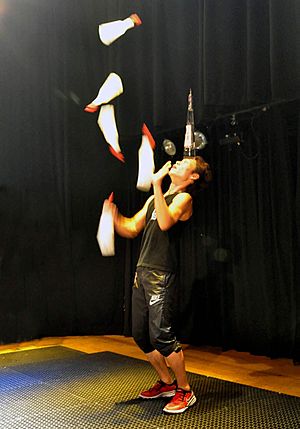Flair bartending facts for kids
Flair bartending is a fun way bartenders entertain people. They do amazing tricks with bar tools, like cocktail shakers, and bottles. It's a bit like juggling! You might see flair bartending in places that serve drinks. It makes the experience more exciting for guests.
Many places want flair bartenders because they help attract customers. Some companies even teach people how to do flair tricks. There are also big competitions where bartenders show off their skills. Flair bartending is sometimes called "extreme bartending." The word "flair" became popular in the mid-1990s. It means any trick a bartender uses to entertain guests while making a drink. This can include juggling, flipping bottles, or even performing close-up magic.
Flair adds a cool show to bartending. It makes the guest experience better. There are two main types of flair: working flair and exhibition flair. Working flair is more common. It focuses on serving drinks quickly while still being entertaining. Exhibition flair is more about competitions. It involves bigger risks and more complex tricks.
Contents
Types of Flair Bartending
There are two main styles of flair bartending. Both need lots of practice and precision.
Working Flair
Working flair is about entertaining guests while making drinks quickly. Bartenders use bottles that have different amounts of liquid in them. They often use a "flat" throw. This means the bottle is released into the air without flipping. It looks like the bottle is floating. This style helps prevent spills. It also lets bartenders use similar tricks with any bottle. Working flair does not slow down the service. It makes the drink-making process fun to watch.
Exhibition Flair
Exhibition flair is usually seen in competitions. Bartenders often use bottles with only a small amount of liquid. This makes them easier to flip and control. Exhibition flair involves longer routines and many objects. Performances are often set to music. This style takes bigger risks. It focuses more on the show than on quick service.
Flair Competitions
Both working flair and exhibition flair are part of competitions. The rules depend on the event. Working flair competitions focus on speed and accuracy. Exhibition flair competitions focus on complex tricks.
History of Flair Competitions
The first open competition with an exhibition round was "Quest for the Best Bartender" in 1995. The first open competition with a working flair round was "Quest for the Best Bartender in the World" in 1999. The very first competition just for working flair was the "Flair Bartenders Shakedown" in 2006. It was organized by BarWars LLC.
Different Competition Styles
Competitions test different skills. For example, the "Legends of Bartending" World Bartender Championships test four areas. These are accuracy, speed, working flair, and exhibition flair. The "Blue Blazer" and Independent Flair League in Poland combine flair with mixology. Competitors earn points for both their tricks and creative drinks. Other events, like Roadhouse World Flair, focus only on exhibition flair.
Major Flair Events Around the World
Hundreds of flair bartending competitions happen every year. Most are local events. In 2005, the Flair Bartenders Association (FBA) started the "FBA Pro Tour." This is a series of events where competitors earn points. The person with the most points at the end of the year becomes the Pro Tour Champion.
In 2008, the World Flair Association launched the "Grand Slam." This is a huge worldwide tournament. It includes the best competitions from all over the world. Many bartenders travel far to compete in Grand Slam events. They want to earn the title of Grand Slam World Champion. These events take place in Europe, Asia, and America.
Some of the biggest flair bartending events include:
- Roadhouse World Flair in London, UK
- Legends of Bartending in Las Vegas, US (no longer held)
- Quest in Orlando, US (no longer held)
- Skyy Global Flair Challenge (held in many countries, no longer held)
- Hard Rock Cafe has held a global "BARocker working flair competition" since 2013.
The International Bartenders Association was founded in 1951. In 2000, they started their own World Flair Competition. This event happens every year. It is held alongside their World Classic Cocktail Competition.
See also
 In Spanish: Coctelería acrobática para niños
In Spanish: Coctelería acrobática para niños


